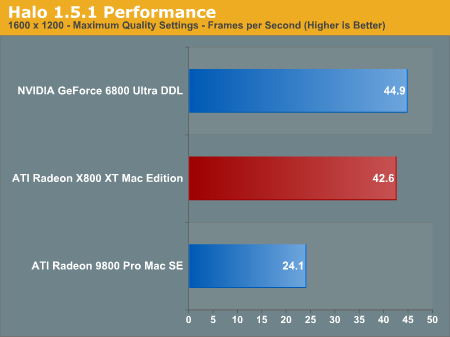ATI Radeon X800 XT Mac Edition: Competition in the Mac Market
by Anand Lal Shimpi on January 5, 2005 7:38 PM EST- Posted in
- Mac
Halo Performance
We list Halo as our most important game benchmark because it is the only test here to make reasonable use of pixel shaders, which again matters more for future games as well as OS X Tiger. Granted the shaders used here are not indicative of those that will be used in other games, but it’s important to look at shader tests whenever possible.

As you can expect, the X800 XT Mac Edition is significantly faster than the older 9800 Pro. With twice as many pixel pipes and more memory bandwidth, high resolution performance is improved significantly. The 6800 Ultra DDL ends up being 5% faster at 1600 x 1200 thanks to more memory bandwidth, but at lower resolutions the two are basically tied.

Enabling Anti-Aliasing is possible on the Mac version of Halo and thus we use it as our AA test as well:

At 1024 x 768 with 4X AA enabled it’s clear that the X800 and 6800 are in a totally different class of performance than the 9800, thus we excluded the 9800 from all higher resolution tests.
Interestingly enough while the 6800 Ultra was faster at high resolution tests, with AA enabled the advantage is clearly given to the X800 XT. The X800 XT’s higher fill rate appears to be more useful here than the 6800 Ultra’s memory bandwidth advantage, giving the AA performance nod to ATI over NVIDIA.










35 Comments
View All Comments
a2daj - Wednesday, January 5, 2005 - link
I forgot to add that I enjoyed the depth of the article, particularly the information about dual-link DVI. Hopefully, that will clear up some common misconceptions regarding DL DVI.aliasfox - Wednesday, January 5, 2005 - link
I applaud the Mac benchmarking- handled in a fair and objective manner, with the professionalism I've come to expect from AnandTech. If you can get your hands on Motion, that is apparently a non-game graphics card intensive program.As I read through the article, I missed one important fact: what setting is the processor set on the G5? All G5 desktops offer the option of running the processor always at highest (in this case, 2.0 GHz), or at a lower speed, the "Reduced" setting. Reduced cranks up processor performance on demand, but the performance difference between that and Highest is still noticeable under the type of scrutiny that AnandTech does.
Now, before any PC user wonders why there are power settings on a desktop machine, let me offer an answer: when you don't need the processor (when you're typing in Word, for example), it throttles down, allowing the entire computer to run cooler, and therefore quieter, as the fans can then run at lower speeds.
a2daj - Wednesday, January 5, 2005 - link
Battlefield 1942 and Jedi Outcast as well as Jedi Academy are both available for Mac OS. Same with Call of Duty. I'm surprised he ended up resorting to RtCW. Call of Duty would have been a more interesting test. Splinter Cell is also available. Anand, if you'd like any info on what to test for Mac gaming I'd be happy to provide some suggestions, particularly when it comes to some of the Mac specific settings in various games.Xbench... ugh. The OpenGL test in Xbench is useless. It's shown scores which allude to a Rage 128 being faster than a Radeon 9800 Pro.
skunkbuster - Wednesday, January 5, 2005 - link
that 6800 Ultra DDL is freakin HUGE!shabby - Wednesday, January 5, 2005 - link
How aboot some doom3/farcry/hl2/sw:bf/sims2/battlefield/jedi/ benchmarks? Oh wait... n/m ;)